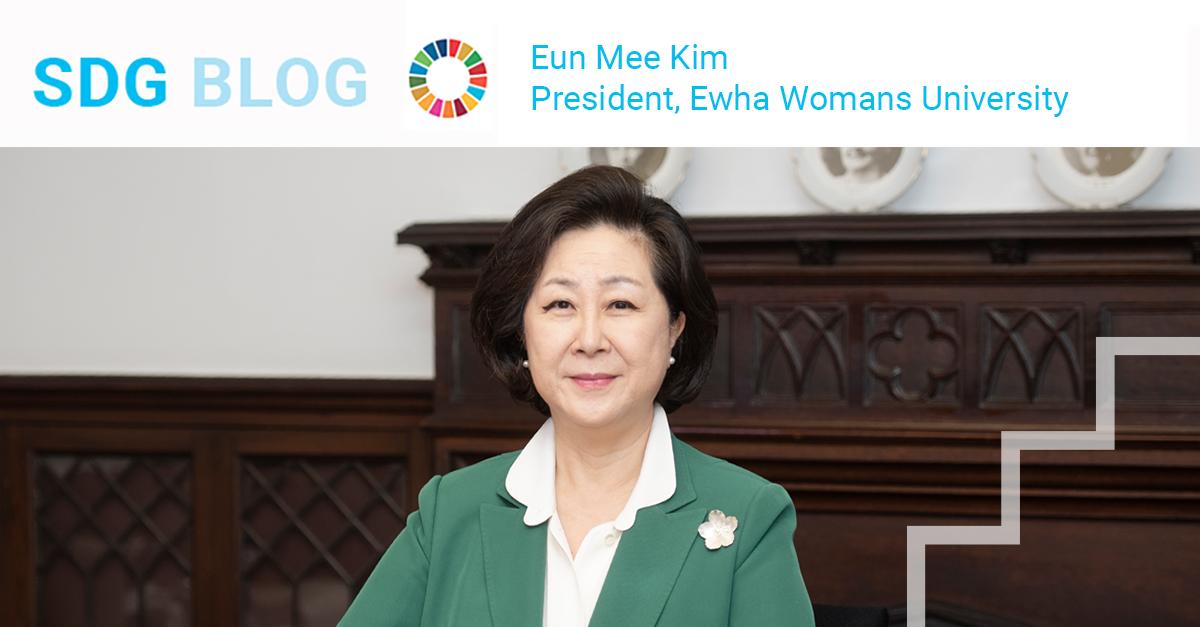SDG Blog

Crisis in education for SDGs: The long-term impact of COVID-19 and the digital transformation
By Eun Mee Kim, President of Ewha Womans University
The promise of the Agenda 2030 to “leave no one behind” has never been so critical as it is now. The COVID-19 pandemic has left such a serious gap in education and gender inequality that reaching the SDGs by 2030 may be just a dream, unless we act now. The goals set forth in the SDGs and, in particular, SDG4, “Ensure inclusive and equitable quality education and promote lifelong learning opportunities for all” must be put back on track. Children suffered when the schools were closed. Even though children were at home being cared for by their parents and participate in on-line classes, many were left out of this opportunity for various reasons including lack of access to proper on-line hardware and software.
Inequality in education increased during the pandemic. This is not difficult to imagine as children from well-off families had access to the full support systems, while many were left out in the Global South, and for some in the Global North as well. Furthermore, many children, including pre-school toddlers, missed out on school meals, which are sometimes their only meal of the day.
The multiple consequences of the pandemic have left many children behind. And, unfortunately, although we are hopeful that the pandemic will be under control soon, the short-term impact will have life-long implications for children. Malnutrition during the pivotal years of early childhood leads to stunting and other life-long health issues. Distance learning, even under the best conditions, has left crucial social interaction and peer relations lost during the children’s development. Also, parents have lost jobs and income, and in some cases, their lives, causing many to fall into poverty.
I am also very concerned about the digital divide which was apparent even before COVID-19 hit the world. The pandemic has accelerated the paradigm shift in education driven by the digital transformation. The critical need for better on-line education hardware and software including IT connection is apparent, yet much of the Global South remains woefully ill-prepared and the gap with the Global North has become wider. Internet connectivity has become even less affordable now due to the decreased income in many countries, particularly in the Global South.
The brain drain of ICT professionals from the Global South to the Global North has exacerbated the digital divide. The need for good-quality higher education in the Global South should no longer be considered a luxury. Higher education and research and development in the Global South should become a major priority if we are to achieve the 2030 Agenda and its SDGs. Sustainable and long-term development and retention of skills for the digital transformation must start in earnest in the Global South.
Finally, we have witnessed rising gender inequality around the world. Women were left behind again with the pandemic. They were performing the bulk of household duties while the world stopped: they were the primary caretakers of children and the elderly during lockdown, they were forced to quit their jobs at a much higher rate than their male counterparts, and their professional productivity suffered. Thus, gender inequality, an important component of inequality that must be addressed to achieve the 2030 Agenda, should be addressed as a priority now. The digital transformation and the greater significance of the science, technology, engineering, and math (STEM) fields for the future has become even more evident with the pandemic. And unfortunately, women and girls’ access to STEM education, training and jobs were already very low, and the pandemic has exacerbated and accelerated this trend.
We must take stock of the short-term pandemic-era challenges and address them. However, even more important is how to mitigate and turn back the clock for long-term and possibly permanent damages caused by the pandemic to children, women and men. The SDGs serve as a guidepost. Now, it is even more critical to use the goals as the navigation targets of what we must do as we are seeing the light at the end of the pandemic tunnel. We need to act now.
Calls for Action:
(1) Reaffirm SDG4 for inclusive and equitable quality education.
(2) Reemphasize the importance of integrating SDG4 with other SDGs including SDG5 (gender equality), and SDG10 (reduced inequalities).
(3) Ensure that education in science and technology for digital transformation is provided inclusively and equitably around the world with special attention to the Global South with SDG17 (partnerships for the goals).
(4) Ensure that the short-term impact of COVID-19 does not turn into permanent inequalities.
* The views expressed in this blog are the author’s and do not necessarily reflect the opinion of UN DESA.
 Welcome to the United Nations
Welcome to the United Nations